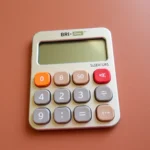Master the Scientific Calculator with Fraction functions! Unlock powerful calculations and enhance your math skills with our expert tips and guides.
Scientific Calculator
with Fractions, History & Settings
History
How to Use
- Perform calculations using numbers and operators
- Use scientific functions (sin, cos, log, etc.)
- Press “=” to see the result
- Press “a/b” to convert decimals to fractions
- AC = Clear All, C = Clear Entry, ⌫ = Backspace
Tips & Tricks
- Long calculations? Use parentheses ( ) to control order.
- Use “Ans” from History to reuse results.
- Convert results into fractions for better understanding.
- Switch to Light/Dark mode in Settings for comfort.
Settings
Table of Contents
Discover the essential features and functionalities of scientific calculators, focusing on fraction operations and advanced mathematical calculations. This comprehensive guide explores how to effectively use scientific calculators for a variety of math tasks, including addition, subtraction, multiplication, and division of fractions. Learn tips for converting decimals to fractions, using special keys, troubleshooting common mistakes, and maximizing your calculator’s potential for academic and professional success. Whether you’re a student or a professional, mastering these tools can significantly enhance your mathematical proficiency.
Introduction to Scientific Calculators
Scientific calculators are essential tools for students, professionals, and anyone engaged in mathematical-related tasks. Unlike simple calculators, scientific calculators are designed to perform a wide array of complex mathematical functions, enabling users to solve equations, evaluate trigonometric functions, work with logarithms, and handle statistical data with ease. Their design caters not just to basic arithmetic but also to advanced calculations that are common in fields such as engineering, physics, and mathematics.
One significant feature of scientific calculators is their ability to manage fractions effectively. This functionality allows users to perform operations involving fractions without converting them into decimal form, thus simplifying calculations and improving accuracy. Mastery of fraction functions can enhance proficiency in mathematics, making it easier for users to engage with higher-level concepts and problem-solving techniques.
Furthermore, scientific calculators are equipped with a range of functions including parentheses for grouping operations, exponents for powers, and functions for calculating roots, which all serve to make complex calculations more manageable. Many models also include additional features such as memory storage, programmable functions, and graphing capabilities, which further expand their utility. Understanding how to navigate these features is crucial for students who may find themselves facing rigorous coursework, as well as for professionals who require precision and efficiency in their calculations.
In essence, the importance of scientific calculators cannot be overstated. Familiarity with their functions, especially those related to fractions, empowers users to tackle more intricate calculations with confidence. As such, investing time in mastering a scientific calculator can significantly benefit one’s mathematical journey, ensuring that users not only complete tasks with greater ease but also cultivate a deeper understanding of mathematical principles.
Understanding the Fraction Button
Scientific calculators are essential tools for students and professionals alike, particularly for those frequently working with fractions in their mathematical problems. Among the myriad features these calculators offer, the fraction button stands out for its practicality and efficiency in simplifying computations involving fractional numbers. This feature allows users to perform operations such as addition, subtraction, multiplication, and division involving fractions seamlessly, which can significantly save time and reduce errors compared to manual calculations.
When using the fraction button, users can input fractions in a clear and concise manner. Most scientific calculators enable the entry of fractions in the format of a numerator and denominator. For example, to input the fraction two-thirds, a user would typically enter ‘2’ followed by the fraction button and then ‘3.’ This intuitive format not only aligns with common mathematical practices but also allows the calculator to recognize the values as a single entity. Consequently, this enhances the accuracy of calculations, especially during complex problem-solving scenarios.
Additionally, the fraction button caters to a variety of functions, enhancing its utility beyond basic arithmetic operations. Users can convert improper fractions into mixed numbers and vice versa, a skill vital for subjects involving ratio and proportion. The built-in fraction functions can also simplify fractions automatically, making the results clear and straightforward. Given the importance of accuracy in mathematics, especially in fields such as engineering, physics, and finance, the efficiency rendered by the fraction button significantly contributes to academic and professional success.
With ongoing advancements in technology, understanding and utilizing the fraction button on scientific calculators is more crucial than ever. Mastering this feature not only streamlines calculations but also improves overall mathematical proficiency, which is invaluable in various educational and vocational contexts.
Fraction Conversion Basics
Converting decimals to fractions using a scientific calculator can streamline calculations in various mathematical applications. The process is straightforward, and understanding how to effectively use the fraction functions on your calculator is essential for ensuring accuracy. To begin with, enter the decimal value you wish to convert. Using a scientific calculator, most models feature a dedicated fraction button, typically labeled as “a b/c” or something similar. This button facilitates the conversion process.
Once you’ve input the decimal, press the fraction button. This action prompts the calculator to process the number and display the equivalent fraction. It is important to take note of the settings on your calculator; ensure that it is set to the correct mode (usually ‘normal’ or ‘decimal’) to receive accurate results. After conversion, the scientific calculator may present the fraction in its simplest form, or as a mixed number, depending on the decimal value inputted.
For enhanced accuracy, consider performing a quick manual check of your results. To do this, divide the numerator by the denominator to see if you can obtain the original decimal. This is a simple yet effective verification method. Additionally, you can round your decimal value to a certain number of decimal places before conversion, ensuring the fraction reflects the desired precision level for your solution.
Lastly, it is wise to familiarize yourself with how your specific model handles fractions, as variations may exist between different brands and models of scientific calculators. Understanding the extent of their capabilities will enhance your proficiency in various mathematical contexts, making the process of converting decimals to fractions both efficient and effective.
Performing Basic Calculations
Scientific calculators are versatile tools designed to handle both simple and complex calculations, including those involving fractions. To perform basic calculations using a scientific calculator, one begins with the fundamental arithmetic operations: addition, subtraction, multiplication, and division. Each function is essential for various mathematical tasks and can easily incorporate fractions.
For addition, you would typically input the first number, followed by the addition operator, and then the second number. For instance, if you wanted to compute \( \frac{1}{2} + \frac{1}{4} \), you would first enter \( 1 \), then the division key to input \( 2 \), followed by the addition operator, and then enter \( 1 \), the division key again, and finally \( 4 \). The result would yield \( \frac{3}{4} \). Note that many scientific calculators will automatically convert the answer into a decimal format; thus, you might see \( 0.75 \) as the output.
Subtraction works similarly. To calculate \( \frac{3}{4} – \frac{1}{4} \), input \( 3 \), select the division key to represent \( 4 \), use the subtraction key, and then enter \( 1 \), followed by another division operator, and \( 4 \). The expected outcome would be \( \frac{2}{4} \), which simplifies to \( \frac{1}{2} \).
When dealing with multiplication and division, these operations can also be conducted on fractions. For multiplication, entering \( \frac{1}{2} \times \frac{2}{3} \) involves similar steps: input \( 1 \), use the division key for \( 2 \), select the multiplication operator, enter \( 2 \), and then \( 3 \) with the division key. The result should yield \( \frac{2}{6} \) or simplified, \( \frac{1}{3} \). In division, the process follows suit, where \( \frac{1}{2} ÷ \frac{1}{4} \) would require entering \( 1 \) divided by \( 2 \), then the division operator, followed by \( 1 \) divided by \( 4 \). The output will be \( 2 \).
Exploring Scientific Functions
Scientific calculators are equipped with various functions designed to assist in complex mathematical computations. Among these functions, trigonometric and logarithmic capabilities play a crucial role, especially when dealing with fractions. Understanding how to effectively use these functions can enhance problem-solving efficiency in fields like engineering, physics, and higher mathematics.
The sine (sin), cosine (cos), and tangent (tan) functions are fundamental components of trigonometry. They can be particularly useful for calculating angles and distances, especially in applications involving right triangles. For instance, to determine the sine of a fraction, one might input a fractional angle into the scientific calculator. If the input is 30° (or its equivalent in radians), the calculator will output 0.5, which can be a fractional result in further calculations.
Another vital logarithmic function is the logarithm (log), which is the inverse operation of exponentiation. It is essential for simplifying expressions where the base is 10 or another value. A potential application involves a fraction like 10/100. By utilizing the log function, one can quickly ascertain that log(10/100) equals -1, paving the way for more complex calculations involving exponents. The natural logarithm (ln), which utilizes the mathematical constant e, functions in a similar manner but is typically reserved for expressions in growth rates or natural systems.
When integrating these functions with fractions, it’s essential to recognize how they interact. For example, calculating tan(45°) / 2 yields a fraction result, which is a key element in both theoretical and practical applications. By comprehensively understanding these scientific functions, users can unlock the full potential of their calculators, allowing for efficient solutions to complex mathematical problems involving fractions.
Using Special Keys and Features
To effectively utilize a scientific calculator, especially when handling fractions, it is essential to become familiar with its special keys and features. These functionalities significantly enhance operational efficiency, allowing users to execute calculations with ease and accuracy. Among the most commonly used keys are the equals sign (=), clear all (AC), clear entry (C), and backspace (⌫).
The equals sign (=) is vital in any calculation, representing the completion of an equation and prompting the calculator to display the answer. When working with fractions, incorporating the equals sign is crucial, for it confirms the input and transitions the calculation to its conclusion. For instance, when adding or multiplying fractions, inputting the values followed by the equals sign will yield the correct results immediately.
The clear all (AC) button serves as a reset mechanism, allowing users to clear all previous entries and start anew. This feature is particularly useful in scenarios where multiple calculations are performed in succession, minimizing the risk of errors from retained data. Similarly, the clear entry (C) key enables users to erase the most recent entry without affecting previous calculations. This ensures greater accuracy, especially when refining fractions.
Additionally, the backspace (⌫) button provides the ability to correct mistakes by deleting the last entered digit or operator. This can be especially helpful in fraction input where accuracy is paramount. When users make an erroneous entry, the backspace function allows them to rectify it without needing to restart the entire calculation. Overall, understanding and effectively utilizing these special keys can streamline calculations significantly, leading to enhanced efficiency when working with fractions and various other mathematical functions.
Advanced Fraction Operations
Understanding advanced fraction operations is essential for students and professionals alike, especially when dealing with complex mathematical problems. The scientific calculator can significantly streamline this process, making it easier to manage intricate calculations involving fractions. One of the more challenging aspects of fraction operations includes adding and subtracting mixed numbers.
To effectively add mixed numbers, the first step is to convert them into improper fractions. For instance, a mixed number like 2⅗ can be transformed into an improper fraction by multiplying the whole number by the denominator (2 * 5 = 10) and then adding the numerator (10 + 3 = 13), resulting in 13/5. Once both numbers are converted to improper fractions, they can be added together by finding a common denominator, which may require conversion of either fraction. The scientific calculator simplifies this step; utilizing its fraction functions allows users to enter values directly, producing an accurate result while minimizing algebraic errors.
Subtracting mixed numbers follows a similar process, where each mixed number is first converted into an improper fraction. The key distinction lies in ensuring the fractions are properly aligned for subtraction. If necessary, adjust the fractions by finding a common denominator before subtracting. The scientific calculator’s functionalities can facilitate these necessary adjustments, providing results that are easy to interpret.
Another advanced operation includes performing complex calculations involving multiple fractions, which may require the use of parentheses to direct the order of operations. For example, when calculating (1/3 + 1/4) ÷ (2/5), the scientific calculator efficiently processes each component, yielding an accurate answer without cumbersome manual calculations. Utilizing the fraction functions featured in these calculators not only saves time but also enhances accuracy, making it an invaluable tool for anyone tackling advanced mathematical tasks.
Common Mistakes and Troubleshooting
Using a scientific calculator for fraction calculations can sometimes lead to confusion, particularly for those new to these advanced functions. One common mistake is neglecting to use parentheses correctly. Mathematical operations involving fractions often require careful attention to order of operations, and improper placement of parentheses can yield incorrect results. For instance, entering a calculation as 1/2 + 1/3 without parentheses may lead the calculator to misinterpret the sequence of operations, resulting in a value that does not accurately represent the intended computation.
Another frequent error involves the misinterpretation of fraction inputs. Users may forget to switch the calculator’s mode from decimal to fraction or vice versa. This can lead to an unexpected output format that may be difficult to interpret. To avoid this issue, it is advisable for users to familiarize themselves with the settings and options available on their scientific calculator, ensuring they are in the correct mode before starting calculations.
Additionally, many users encounter problems when trying to reduce fractions. It is important to understand that while most scientific calculators will offer a fraction function, not all will automatically simplify fractions. Users should check the calculator’s capabilities and perform manual reductions when necessary. In some cases, calculators may provide odd or unexpected outputs, prompting confusion. If this occurs, it can be beneficial to double-check each step of the calculation and ensure that all fraction inputs are entered correctly.
Finally, when troubleshooting, refer to the user manual specific to the calculator model. Many common queries and errors are often addressed in the manual, offering effective solutions. Taking the time to understand these functionalities can enhance the user experience, minimize frustrations, and ultimately lead to accurate calculations when working with fractions.
Conclusion and Final Tips
In this blog post, we have explored the essential functions of scientific calculators, specifically focusing on fraction operations. Mastering these functions not only enhances mathematical proficiency but also streamlines problem-solving across various disciplines, from engineering to physics. Understanding how to effectively utilize the fraction functions, such as converting improper fractions to mixed numbers or vice versa, streamlines calculations and minimizes errors. Furthermore, we discussed the significance of knowing how to perform addition, subtraction, multiplication, and division with fractions using these calculators, emphasizing the efficiency they bring to complex mathematical tasks.
To further refine your skills, it is advisable to practice regularly with different types of fraction problems. Engaging in exercises that challenge you to use the scientific calculator to solve real-world mathematical problems can significantly enhance your confidence and proficiency. Consider setting aside time each week to tackle various problems that require fraction manipulation, using the calculator as your tool of choice. By doing so, you will not only become familiar with its functionalities but also develop a deeper understanding of the underlying mathematical principles.
Additionally, we encourage you to explore beyond the basics. Scientific calculators often come equipped with functions that can handle algebraic equations, trigonometric calculations, and statistical analyses. Familiarizing yourself with these features will empower you to utilize the calculator to its fullest potential, whether you are completing homework, preparing for exams, or conducting professional research. Ultimately, investing time in mastering the scientific calculator’s fraction functions will yield tremendous benefits in your mathematical journey, granting you both efficiency and accuracy in your calculations.








